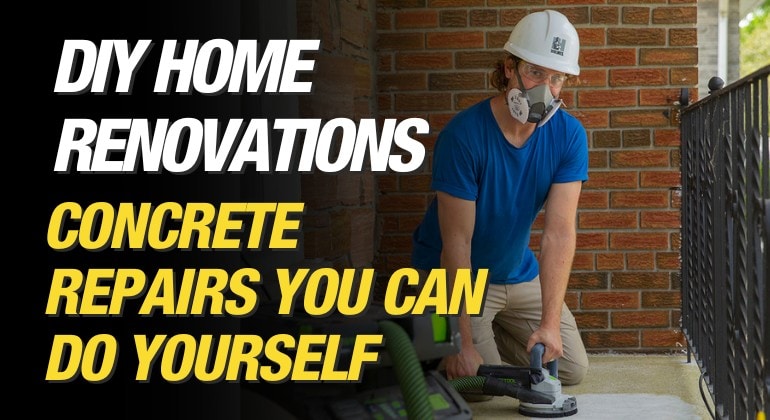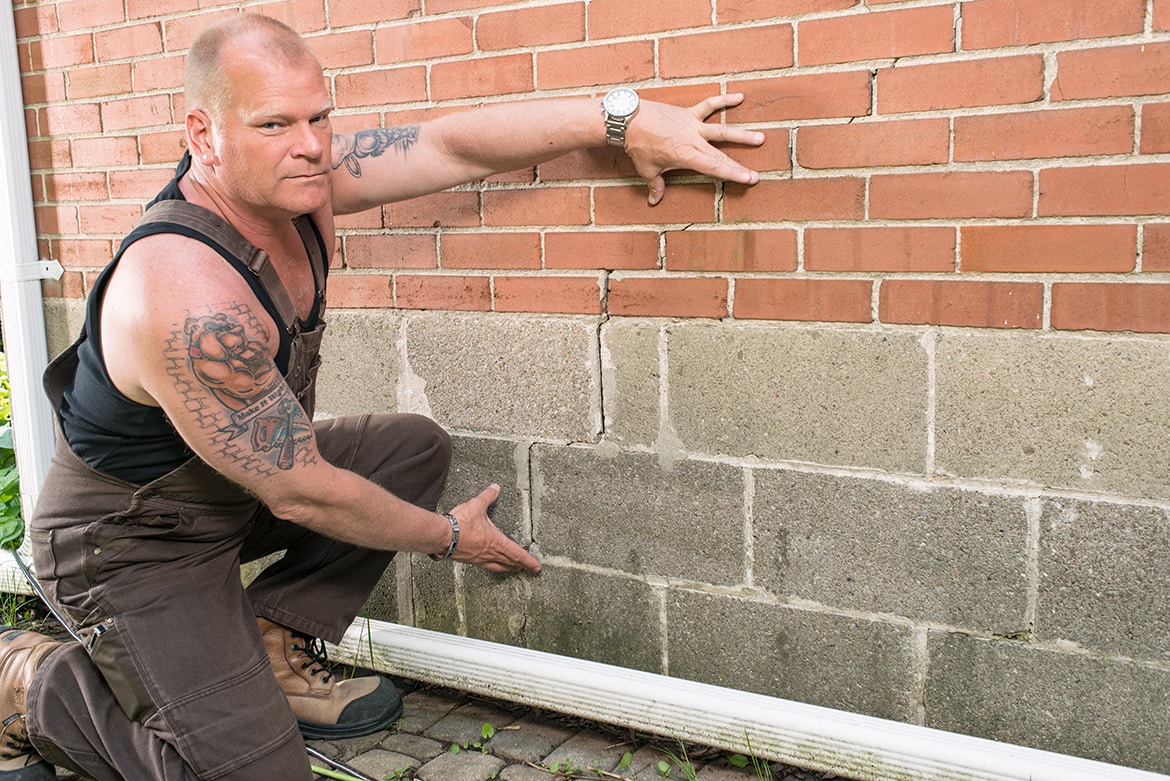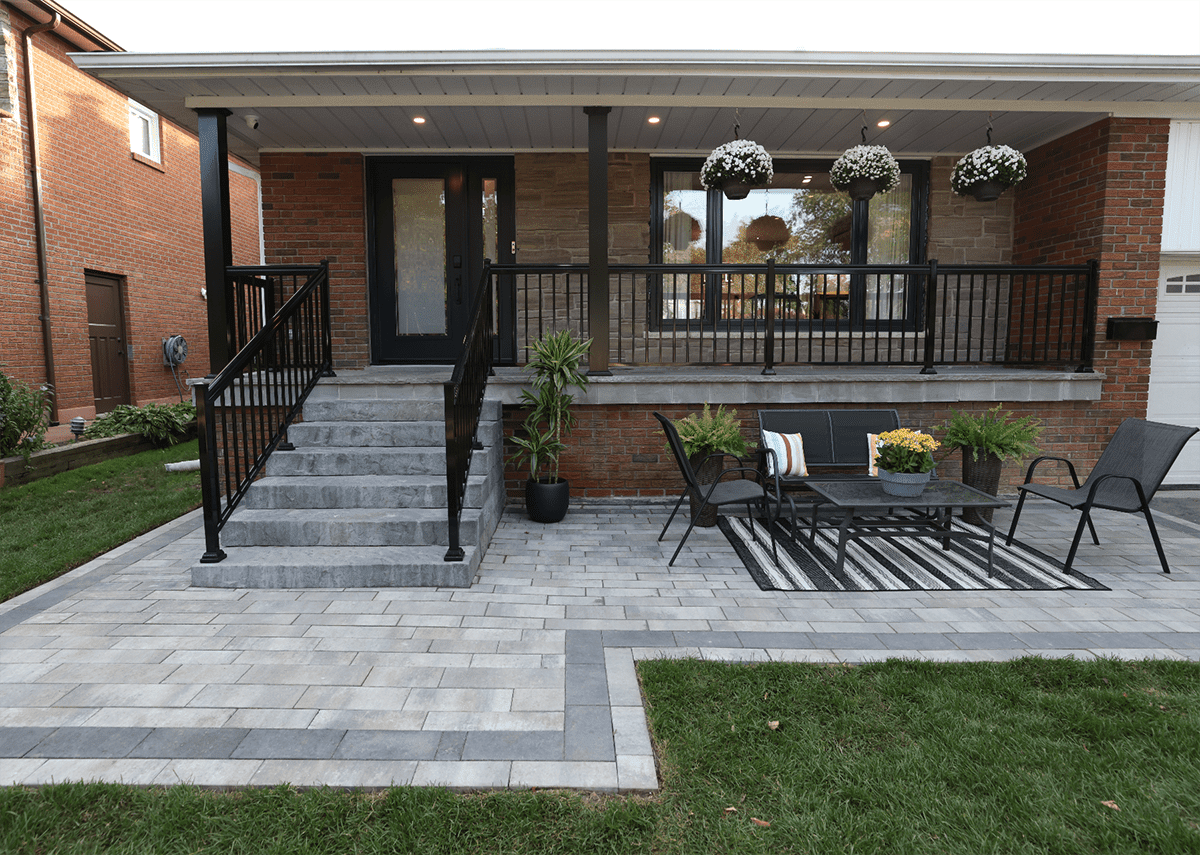Cleaning gutters is one of those chores most homeowners dread—and often put off—but it’s an essential part of protecting your home. Installing gutter guards can significantly cut down on...

DIY Concrete Repairs You Can Do Yourself
By Mike Holmes
Mike’s Advice / Home Renovation
Friday, October 6th, 2023 @ 5:29pm
Thinking of DIY Concrete Repairs? Here’s What You Need to Know
If you’ve watched my shows, you must know all the crazy stuff I come across. I am not a fan of DIY jobs when it comes to major systems in your home, such as your electrical, plumbing and anything structural. However, a few minor repair jobs here and there are fine for a homeowner to take on, like smaller concrete repairs. Just make sure you have the right tools and the right materials.
Concrete surfaces are built to last, but everything requires maintenance. I’ll explain how to fix non-structural concrete cracks —and which products are best for each repair. The key is using the best quality materials and the right installation method.
Before You Get Started
I always recommend putting on a pair of good quality safety gloves and glasses before starting DIY repair jobs. You don’t want to injure yourself trying to fix your house!
Common Causes Of Concrete Damage
Weather, moisture, and normal wear and tear may all cause cracks and defects in concrete surfaces. The sooner you address these issues, the more likely you are to avoid additional deterioration and extend the life of your concrete.
Can you repair the surface of concrete?
Yes, concrete CAN be repaired. With most concrete repair products, you’ll need to start with a clean surface free of debris. A wire brush is a good tool to prepare your concrete for fixing.
#1 Sealing Horizontal Cracks
Horizontal cracks in the concrete outside your home could be concerning. These cracks are usually caused by external factors or shifts in the foundation. Don’t ignore those. They may not necessarily signal a major problem, but I would still address them.
Why? Because if they’re not fixed right away the crack could get bigger with time and cause more damage down the road. It could also allow water to leak in —which would be more expensive to fix.
How To Fix
The Sikaflex® Crack Flex Sealant can fix horizontal cracks up to 1 in (25 mm) wide in concrete and cement slabs. The product itself is textured so it blends in with your concrete surface. It’s also waterproof and self-levelling. It comes ready to use, with no mixing needed.
Uses: Sealing small cracks in your driveways, garages, sidewalks, balconies, pavements, terraces, decks, walkways, steps
Tools needed: Good quality caulking gun
#2 Localized defects or damage to the mortar
Dealing with localized defects or damage to the mortar is a common problem many of you face. The damage usually happens because of exposure to the elements, moisture, or just over time due to regular wear and tear. It may begin with minor cracks or missing chunks, but untreated mortar degradation can lead to aesthetic and eventually structural issues down the road.

For those who don’t know, mortar is what connects bricks, blocks, or stones. And like any other material, it can crack over time.
How To Fix
For a small patch on your masonry or concrete, the Sika Mix&Go® is a good product. The product is easy to use and you don’t need any special equipment to mix it. It mixes directly in the package. You can use this indoors or outdoors.

Sika Mix&Go Repair Mortar is a great product for fixing a small patch on your masonry or concrete.
Uses: filling cracks, repairing stair nosings, stair corners, window sills and thresholds.
Tools needed: Good quality spatula or traditional trowel
RELATED:
#3 Minor repairs on horizontal or vertical surfaces (exterior)
Horizontal cracks on surfaces such as your driveway can be very annoying. These cracks are typically caused by weather, wear and tear, driving your car daily in and out, and movement in the ground and foundation. Don’t ignore this, it impacts your curb appeal. This can also cause long-term damage, especially if water starts to pass through.
How To Fix
If the crack in your cement, mortar or stucco is small enough to only require a filler, the Sika® PowerSet is a good option. It is easy to use and cures fast. Perfect DIY project. I don’t recommend painting over this. Use this for exterior applications only (where there is good ventilation).
Tools needed: You will need a good quality caulking gun for this and a trowel.
Uses: Exterior only! Use for small cracks on concrete walkways, sidewalks, stairs, decks, patios, walls, etc.
Another great product is the Sika FastFix®-130 Power Patch. This is a great and very easy-to-use product that is pre-dosed and packaged for in-bag mixing the bag. This removes a lot of the guesswork when it comes to mixing cement, sand, gravel and water together.
All you have to do is roll the package to rupture the seal, you should hear a pop. This mixes the liquid and the powder components. And since the package is clear you’ll be able to see when it’s all properly mixed. Pour the material directly into the area you are repairing and then smoothen it out.
The mix should harden in 30 minutes to 1 hour and you are good to walk on your concrete surface right away.
Tools needed: You will need a wire brush to clean out the crack
Uses: Exterior only! Use for small cracks on concrete driveways, basement floors, patios, and interior and exterior floors
RELATED:
#4 Waterproofing and Weatherproofing Concrete
It is important that you make sure that your concrete surfaces can withstand the weather —especially with all the storms we’ve been seeing more of lately. But this is where waterproofing and weatherproofing come into play. This step helps to protect your concrete from rain, snow, and temperature swings, maintaining its structural integrity and preventing it from cracking.
How To Fix
The Sikaflex® Concrete Fix has excellent adhesion. It works well on joints and cracks up to 1 in wide and ½ in deep. This is suitable for horizontal and vertical applications.
Uses: Weatherproofing joints, cracks and gaps in concrete, brickwork, blockwork, masonry, stucco and metal. Joints in walls, floors, balconies and around window or door frames. Waterproofing of expansion joints and joints or intersections in roofs
Tools needed: You will need a good quality caulking gun for this.
#5 Repairing Concrete Steps
Due to foot traffic and exposure to the elements, concrete stairs can start to crack, chip, and wear over time. To repair them, start by properly cleaning the surface to get rid of any dirt and debris. Then, for small cracks, use a reliable concrete patching product that is made for this specific application.

Concrete steps fixed for Bernadine’s house. Holmes Family Rescue Season 1.
How To Fix
Before you start any concrete repair project, it’s important to assess the extent of the damage. This will help you determine what product and quantity you need for the job.
You’ll also need to gather some tools, including a wire brush, a hammer, a chisel, a trowel, safety goggles, and gloves.
Now for the product, I recommend using the Sikacryl Ready-Mix Concrete Patch. This is a great gap filler for walkways, sidewalks, and stairs. It is a ready-to-use, textured concrete patch for repairing small spalls and cracks in concrete. This makes it great for DIYers looking to fix this themselves. It is also very fast-setting —in as little as 2 to 4 hours.
Another alternative is Sika’s HPB (High Performance Bedding). This is a game-changer when it comes to repairing and fixing concrete steps. It creates a great foundation for your concrete repairs, securing step treads and risers in place, and preventing shifting or cracking over time.
For more serious damage, it’s best to hire a pro to do the repair. They’ll likely use a concrete resurfacer to produce a smooth, uniform surface. They’ll also help address any underlying issues that could have contributed to the damage, such as water drainage problems. After the stairs have been fixed, a high-quality concrete sealer may help protect them from further damage and keep them looking new.
RELATED:
SAFETY ON THE JOB
Remember that safety is extremely important during the repair procedure, so wear proper safety equipment and carefully follow the product instructions. By following these steps, you can ensure that your concrete stairs are not only functional but also add to the overall look of the front walkway to your house.

My son, Mike Holmes Jr. fixing a concrete front porch for Bernadine’s Home. Holmes Family Rescue Season 1.
DIY concrete repairs are not hard if you do your research and have the right, materials and tools. Remember that your safety is the number one thing, so always take the proper precautions and don’t be afraid to ask for help when needed. You can boost the durability and appeal of your concrete surfaces with dedication and a little know-how, adding value to your home for years to come.
Disclaimer: I only recommend products I would use myself and all opinions expressed here are our own. This post may contain affiliate links.
READ NEXT:
Indoor Fall House Maintenance Checklist
Fall House Exterior Maintenance Checklist
DIY Home Inspection: 11 Home Defects Every Homeowner Should Lookout For







